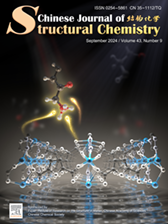
Luminescent coordination polymers with mixed carboxylate and triazole ligands for rapid detection of chloroprene metabolite
Yue Mao, Zhonghang Chen, Tiankai Sun, Wenyue Cui, Peng Cheng, Wei Shi* Submit a Manuscript
Yue Mao, Zhonghang Chen, Tiankai Sun, Wenyue Cui, Peng Cheng, Wei Shi*
Chin. J. Struct. Chem., 2024, 43: 100353. DOI: 10.1016/j.cjsc.2024.100353
September 15, 2024
Chloroprene; 1-Hydroxy-2-butanone; Coordination polymers; Luminescent detection; Sensing mechanism
ABSTRACT
Chloroprene is a monomer widely used in the production of neoprene, and 1-hydroxy-2-butanone (1H2B) is one of the metabolites of chloroprene in urine, which can place a significant impact on human health by disrupting the normal structure and function of DNA. Herein, a three-dimensional Zn-based coordination polymer (1) and a two-dimensional Cd-based coordination polymer (2) were synthesized with mixed ligands of 2,5-furandicarboxylic acid (H2FDA) and 1,2,4-triazole (Htrz) and fully characterized. 2 exhibits excellent stability and superior sensing performance for 1H2B with fast response within 15 s, good recyclability and a detection limit of 9.24 μM. In addition, 2 demonstrates good selectivity in presence of main coexisting compounds in urine. In-depth investigations of the sensing mechanism revealed that the luminescence sensing is based on the competitive absorption and photoelectron transfer processes.






